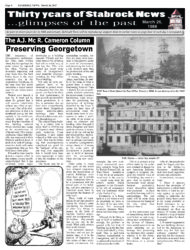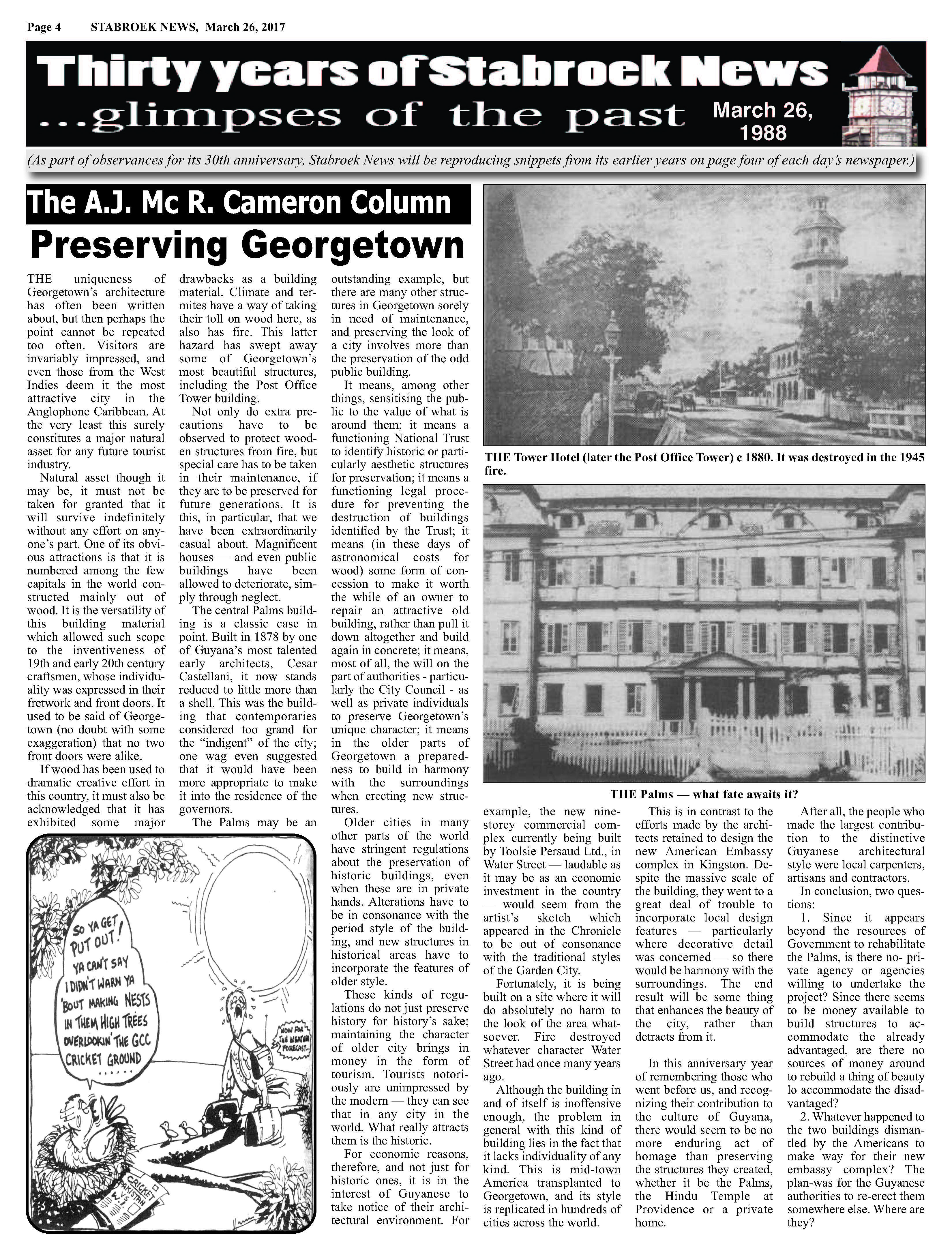Preserving Georgetown
THE uniqueness of Georgetown’s architecture has often been written about, but then perhaps the point cannot be repeated too often. Visitors are invariably impressed, and even those from the West Indies deem it the most attractive city in the Anglophone Caribbean. At the very least this surely constitutes a major natural asset for any future tourist industry.
Natural asset though it may be, it must not be taken for granted that it will survive indefinitely without any effort on anyone’s part. One of its obvious attractions is that it is numbered among the few capitals in the world constructed mainly out of wood. It is the versatility of this building material which allowed such scope to the inventiveness of 19th and early 20th century craftsmen, whose individuality was expressed in their fretwork and front doors. It used to be said of Georgetown (no doubt with some exaggeration) that no two front doors were alike.
 If wood has been used to dramatic creative effort in this country, it must also be acknowledged that it has exhibited some major drawbacks as a building material. Climate and termites have a way of taking their toll on wood here, as also has fire. This latter hazard has swept away some of Georgetown’s most beautiful structures, including the Post Office Tower building.
If wood has been used to dramatic creative effort in this country, it must also be acknowledged that it has exhibited some major drawbacks as a building material. Climate and termites have a way of taking their toll on wood here, as also has fire. This latter hazard has swept away some of Georgetown’s most beautiful structures, including the Post Office Tower building.
Not only do extra precautions have to be observed to protect wooden structures from fire, but special care has to be taken in their maintenance, if they are to be preserved for future generations. It is this, in particular, that we have been extraordinarily casual about. Magnificent houses — and even public buildings have been allowed to deteriorate, simply through neglect.
The central Palms building is a classic case in point. Built in 1878 by one of Guyana’s most talented early architects, Cesar Castellani, it now stands reduced to little more than a shell. This was the building that contemporaries considered too grand for the “indigent” of the city; one wag even suggested that it would have been more appropriate to make it into the residence of the governors.
The Palms may be an outstanding example, but there are many other structures in Georgetown sorely in need of maintenance, and preserving the look of a city involves more than the preservation of the odd public building.
It means, among other things, sensitising the public to the value of what is around them; it means a functioning National Trust to identify historic or particularly aesthetic structures for preservation; it means a functioning legal procedure for preventing the destruction of buildings identified by the Trust; it means (in these days of astronomical costs for wood) some form of concession to make it worth the while of an owner to repair an attractive old building, rather than pull it down altogether and build again in concrete; it means, most of all, the will on the part of authorities – particularly the City Council – as well as private individuals to preserve Georgetown’s unique character; it means in the older parts of Georgetown a preparedness to build in harmony with the surroundings when erecting new structures.
Older cities in many other parts of the world have stringent regulations about the preservation of historic buildings, even when these are in private hands. Alterations have to be in consonance with the period style of the building, and new structures in historical areas have to incorporate the features of older style.
These kinds of regulations do not just preserve history for history’s sake; maintaining the character of older city brings in money in the form of tourism. Tourists notoriously are unimpressed by the modern — they can see that in any city in the world. What really attracts them is the historic.
For economic reasons, therefore, and not just for historic ones, it is in the interest of Guyanese to take notice of their architectural environment. For example, the new nine-storey commercial complex currently being built by Toolsie Persaud Ltd., in Water Street — laudable as it may be as an economic investment in the country — would seem from the artist’s sketch which appeared in the Chronicle to be out of consonance with the traditional styles of the Garden City.
Fortunately, it is being built on a site where it will do absolutely no harm to the look of the area whatsoever. Fire destroyed whatever character Water Street had once many years ago.
Although the building in and of itself is inoffensive enough, the problem in general with this kind of building lies in the fact that it lacks individuality of any kind. This is mid-town America transplanted to Georgetown, and its style is replicated in hundreds of cities across the world.
This is in contrast to the efforts made by the architects retained to design the new American Embassy complex in Kingston. Despite the massive scale of the building, they went to a great deal of trouble to incorporate local design features particularly where decorative detail was concerned so there would be harmony with the surroundings. The end result will be some thing that enhances the beauty of the city, rather than detracts from it.
In this anniversary year of remembering those who went before us, and recognizing their contribution to the culture of Guyana, there would seem to be no more enduring act of homage than preserving the structures they created, whether it be the Palms, the Hindu Temple at Providence or a private home.
After all, the people who made the largest contribution to the distinctive Guyanese architectural style were local carpenters, artisans and contractors.
In conclusion, two questions:
- Since it appears beyond the resources of Government to rehabilitate the Palms, is there no- private agency or agencies willing to undertake the project? Since there seems to be money available to build structures to accommodate the already advantaged, are there no sources of money around to rebuild a thing of beauty lo accommodate the disadvantaged?
- Whatever happened to the two buildings dismantled by the Americans to make way for their new embassy complex? The plan-was for the Guyanese authorities to re-erect them somewhere else. Where are they?

